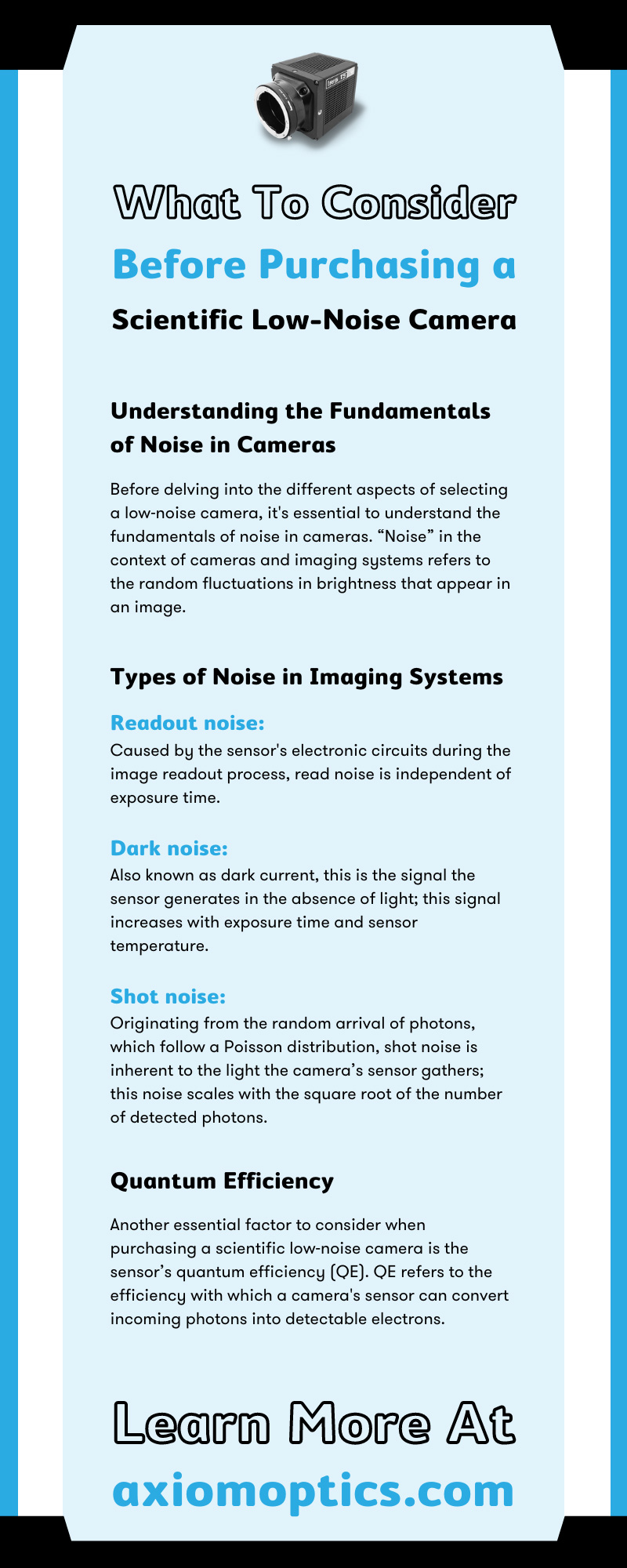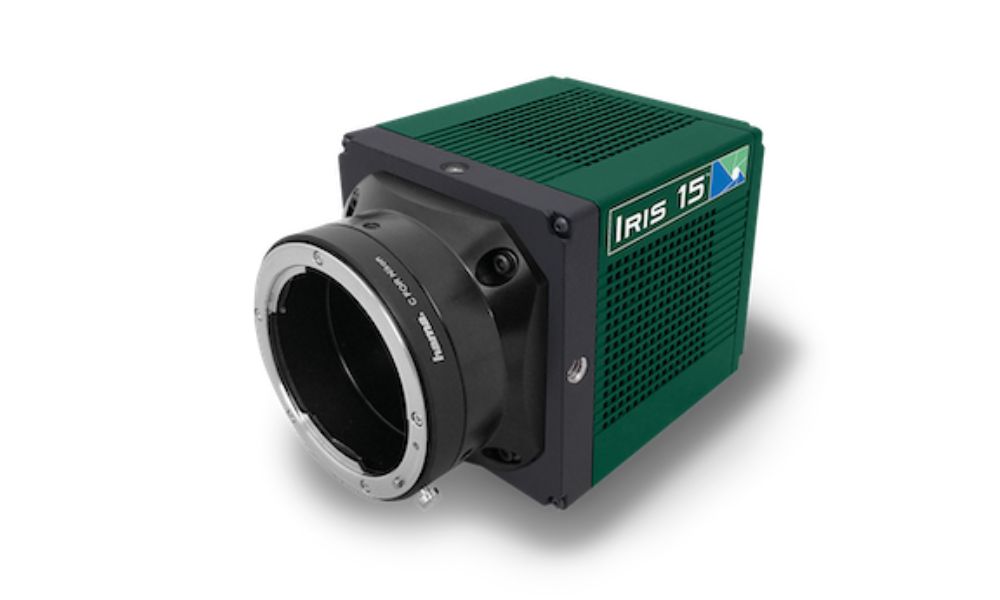Scientific low-noise cameras are specialized imaging devices designed to provide high-quality, low-noise images for various research, engineering, and industrial applications. These cameras are essential for producing accurate data, particularly in low-light conditions, high-speed imaging, or situations where noise reduction is crucial. Learn what to consider before purchasing a scientific low-noise camera for your research or industrial applications to ensure you make the right choice for your needs.
Understanding the Fundamentals of Noise in Cameras
Before delving into the different aspects of selecting a low-noise camera, it’s essential to understand the fundamentals of noise in cameras. “Noise” in the context of cameras and imaging systems refers to the random fluctuations in brightness that appear in an image.
These fluctuations can appear as an unwanted grainy or speckled pattern, reducing the clarity and detail of the image. A variety of factors cause noise, and these are unique to each camera and imaging system, based on the size, type, and quality of the camera sensor, the type of light (visible, near-infrared, or ultra-violet) imaged, the camera senses, and the electronics used to convert the electrical signals into a digital image.
Types of Noise in Imaging Systems
Cameras and associated imaging systems experience perturbations from a variety of sources. We can classify those perturbations as one or more of several types of noise:
Readout noise: Caused by the sensor’s electronic circuits during the image readout process, read noise is independent of exposure time.
Dark noise: Also known as dark current, this is the signal the sensor generates in the absence of light; this signal increases with exposure time and sensor temperature.
Shot noise: Originating from the random arrival of photons, which follow a Poisson distribution, shot noise is inherent to the light the camera’s sensor gathers; this noise scales with the square root of the number of detected photons.
Understanding these different noise sources can help you evaluate the effectiveness of a low-noise camera in reducing noise according to specific conditions and requirements.
Sensor Type: CCD vs. CMOS
Sensor type plays a significant role in determining the performance of a low-noise camera. There are two main sensor types available: Charge-Coupled Device (CCD) and Complementary Metal-Oxide-Semiconductor (CMOS). While both sensors have advantages, CMOS sensors have become more prevalent in recent years due to advances in technology and manufacturing techniques.
CCD sensors have excellent image quality, low read noise, and high quantum efficiency (the conversion of photons into detectable electrons). CCD cameras have been the go-to choice for many scientific applications. However, they are generally more expensive and consume more power than CMOS sensors.
CMOS sensors have improved in read noise, quantum efficiency, and manufacturing techniques, matching or even surpassing CCD sensors in performance. Furthermore, they usually are much faster, consume less power, and are more cost-effective. This makes them an excellent option for low-noise applications.
Considering your imaging requirements, budget, and power consumption constraints, you can choose the appropriate sensor type for your low-noise camera.
Quantum Efficiency
Another essential factor to consider when purchasing a scientific low-noise camera is the sensor’s quantum efficiency (QE). QE refers to the efficiency with which a camera’s sensor can convert incoming photons into detectable electrons.
High QE is desirable for low-light imaging and critical for scientific applications where the signal-to-noise ratio plays a vital role in data accuracy. Look for cameras with high QE across a broad spectral range, ensuring reliable performance across various wavelengths and imaging conditions.
Pixel Size
Pixel size can influence the sensitivity and spatial resolution of a camera. Larger pixels can collect more photons, leading to increased sensitivity and improved low-light performance. However, larger pixels also mean lower spatial resolution, as fewer pixels are available to resolve finer details within the image.
Ideal pixel size can be estimated by calculating the point spread function (PSF) of your imaging system and making sure the camera does not undersample and limit the resolution. Ideally, you will use the biggest pixel size you can afford while not limiting the resolution of the overall imaging system.
The trade-off between pixel size and spatial resolution is important when choosing a low-noise camera. Your pixel size will depend on your application’s specific imaging requirements.
Cooling
Cooling plays an important role in reducing noise in imaging systems by minimizing dark noise caused by heat generated within the camera. There are two main types of cooling available for low-noise cameras: thermoelectric cooling and liquid cooling.
Thermoelectric cooling, or Peltier cooling, uses a thermoelectric cooler to remove heat from the camera’s sensor. This method is effective at reducing noise but has limitations in the extent of cooling it can achieve.
Liquid cooling involves circulating a coolant, such as water, through the camera to remove heat from the sensor. This method is more effective at reducing noise than thermoelectric cooling but is more complex and may require additional equipment.
As the dark noise is proportional to the integration time, some applications usually do not require extensive cooling. For instance, the contribution of dark noise in high-speed imaging (100+ fps) will most of the time be negligible compared to the readout noise. On the other hand, if you need a very long exposure time, like in astronomy, cooling is very important to bring the dark noise as low as possible.
Consider the extent of cooling required for your specific imaging needs and choose a camera with a cooling system that meets those requirements.
Dynamic Range and Readout Noise
Dynamic range refers to the ratio between the maximum and minimum signals a camera can detect. This is important in situations with significant variations in photon count, such as in astrophotography or fluorescence imaging.
Dynamic range can be calculated from the pixel full well capacity divided by the readout noise. It is also important to consider the bit depth of the camera, which, in some cases, can limit the dynamic range.
Choose a high-dynamic range camera that can capture bright and dim signals without saturating or losing detail.
Speed and Resolution
In many scientific applications, high-speed imaging is necessary to capture details that occur within a short time frame. Speed is usually influenced by the sensor resolution so that one camera can achieve a higher frame rate at 512×512 resolution than at 2048×2048.
Some cameras offer more than one readout mode, with one mode dedicated to high-speed imaging. Pay attention to the effective readout noise, dynamic range, and sensitivity in those different modes, as they will affect the image quality.
Consider your imaging requirements and choose a camera with the necessary resolution and frame rate that can capture the details you need without sacrificing image quality or increasing noise.
Choosing a scientific low-noise camera (SCMOS camera) requires careful consideration of the various factors that influence the camera’s performance. Understanding the fundamentals of noise in cameras, choosing the appropriate sensor type, and considering quantum efficiency, pixel size, cooling, dynamic range, speed, and resolution are all important factors.
By carefully considering these factors and evaluating different products on the market, you can find a low-noise camera that meets your specific imaging needs and produces high-quality, reliable data for your research or industrial applications. Contact Axiom Optics technical sales team when purchasing a scientific low-noise camera. We supply advanced SCMOS cameras for various scientific and industrial applications. Browse our collection and contact us with any questions you may have.


